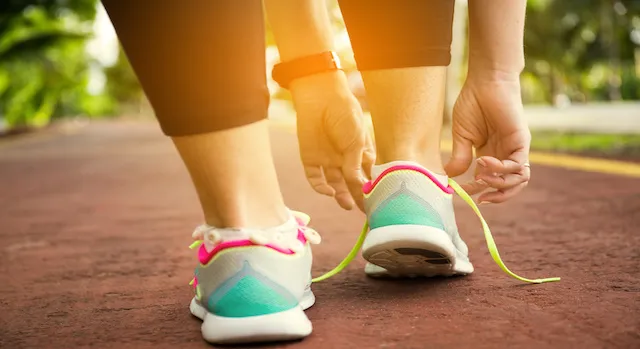
- Share on Facebook59
- Share on Pinterest
- Share on Twitter
For many of us, hitting the gym is not always convenient. And the truth is, not all of us are natural gym rats. While some can’t imagine life without their favorite Spin class, for others, going to the gym is not as enticing. So what do you do if you’re looking to start an aerobic exercise routine without a trip to the gym every day? Speed walking might be just what you’re looking for. It’s convenient, relatively cheap (you just need to buy good shoes) and a potentially less intimidating entry into aerobic exercise than running. Here are six reasons to consider taking it up.
It can prolong your life
A 2013 study published on the online peer-reviewed journal PLOS ONE suggested that those who speed walk for exercise regularly may live longer than those who walk regularly but at a slower pace. Paul Williams, the researcher who led the study, said, “Our results do suggest that there is a significant health benefit to pursuing a faster pace.” Pushing your body a bit, he explained, appears to have physiological benefits that walking at a slower pace doesn’t offer — even if the length of the slower walk is extended.
Heart health
As with most aerobic activity, speed walking can improve the health of your heart. The same study found that walking at a brisk pace is associated with a lower risk of cardiovascular disease, ischemic heart disease, heart failure and hypertensive heart disease, as well as diabetes and dementia. The study demonstrated that the faster the pace you walk, the lower your risk for all of these conditions. Of course, there are caveats; perhaps the slowest walkers in the study had been facing additional health problems, for example.
Help your mood
In addition to the physiological benefits of speed walking, it can also benefit your mental health. According to Mayo Clinic, speed walking can help to significantly improve your mood. This is likely due to the fact that during exercise your brain reduces endorphins, the chemicals that reduce your perception of pain. And of course, to many of us, this resonates with our lived experiences. How many times have you felt angry or frustrated, then gone on a walk to clear your head and felt significantly calmer afterward?
Bone and muscle health
According to a review published by the Ramblers and Macmillan Cancer Support, walking improves the strength of both bones and muscles. For example, the review explains that physical activity, including walking, can decrease the risk of hip fracture by 36 to 68 percent. And of course, aerobic exercise that involves the use of large muscle groups will certainly help to strengthen those muscles.
Reduced risk of cancer
 Because of the myriad ways that physical activity helps to improve health, it can also help to reduce the risk of cancer. According to the same review, regular physical activity like walking can reduce the risk of colon cancer by 30 to 50 percent and breast cancer by about 20 percent.
Because of the myriad ways that physical activity helps to improve health, it can also help to reduce the risk of cancer. According to the same review, regular physical activity like walking can reduce the risk of colon cancer by 30 to 50 percent and breast cancer by about 20 percent.
Decreased stress
Finally, the Ramblers and Macmillan review explains that walking can help to reduce your overall level of stress, as well. This is likely due in part to the endorphins that are released during exercise and a decrease in stress caused by other physical ailments that physical activity can prevent.
Clearly, speed walking is a great option for many of us. If you’re looking to begin a new exercise routine, it might be a perfect fit.
—Sarah Cooke
Sarah Cooke, is a Certified Body Image and Eating Psychology Coach and writer who is passionate about organic food and helping others heal at the deepest level.
Sources:
http://journals.plos.org/plosone/article?id=10.1371/journal.pone.0081098
http://well.blogs.nytimes.com/2013/12/04/why-a-brisk-walk-is-better
http://www.mayoclinic.org/healthy-lifestyle/fitness/in-depth/walking/art-20046261
https://www.walkingforhealth.org.uk/sites/default/files/Walking%20works_summary_AW_Web.pdf
- Share on Facebook59
- Share on Pinterest
- Share on Twitter

